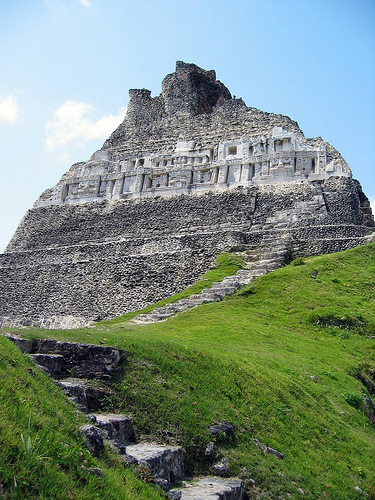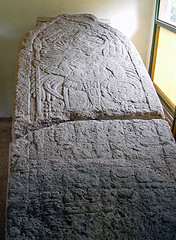

Location: 80 miles (130 km) West of Belize city, Cayo District
Entrance Fee: BZ $15
Open 7:30am- 4pm
Xunantunich is an ancient Mayan site located in the Western Belize in the Cayo District some 80 miles (130 km) West of Belize city. You can get here by bus or by car. The ruins of Xunantunich are situated on top of a ridge overlooking Mopan River that you have to cross with a ferry to get to the site. Historians don't know the original name of the settlement. Xunantunich is a modern name that was given by the archaeologists that means “Stone Maiden”.
Most of pyramids and ceremonial structures in Xunantunich date back to the Maya Classical period between 200 and 900 AD. At its heyday Xunantunich population surpassed 200,000 residents. The earthquake around 900 AD damaged many structures of Xunantunich causing large loss of lives. It was probably one of the main contributing reasons for the downfall of the metropolis. Its residents began to abandon Xunantunich as many saw it as a bad omen from the gods of the underworld.
This notion of the haunting of Xunantunich locals continues even today. Descendents of the Mayan natives consider this site as haunted. Locals claim that a ghost of a woman dressed in white with red glowing eyes visit the site at night. She walks among ruined buildings of Xunantunich, reaches El Castillo and walks into a stone wall.
El Castillo (the castle) is the highest pyramid in Xunantunich and second largest in Belize, second only to pyramid in Caracol. It rises to 40 meters (131 feet) above surrounding jungle. Archeological evidence suggest that it was build in stages from 7th to 9th century AD. Beautiful frescoes adorns the sides of the El Castillo pyramid.
As many Mayan cities Xunantunich did not preserve houses of the common people. They were too small and made of wood so they rotted away fairly quickly in a humid hot climate. However judging by stone remains of temples and palaces the city encompassed an area of about 1 square mile (2.6 sq. km) with 6 ceremonial plazas that had 26 temples and palaces.
Bloodletting was performed on this place by the Mayan priests. Pool was used for collection of sacrificial blood.
Stelae was found that is protected today against weather. Dated back to first century AD it depicts a human figure.

Structure A-1
Structure A-1 was built in the
Late Classic, at around 800 AD. It bisected Plaza A-I, which had
until then been the most important plaza in the site. It now lies on
top of the original ball court of Xunantunich between Structure A-6
(El Castillo) and A-11. It became a ritual space solely for the
rulers and elite, which doubled as an impediment to other public
spaces.
Burial chamber
On July 19, 2016, a team led by
Jaime Awe discovered an untouched burial chamber attached to a
larger building. It is considered to be one of the largest Mayan
burial chambers found within the last 100 years. The chamber
contained the corpse of a male, aged between 20 and 30 years. The
chamber also contained a number of ceramic vessels, obsidian knives,
jade pearls, animal bones and some other artefacts made of stone.
Osteologists believe the man was athletic and quite muscular when he
died.